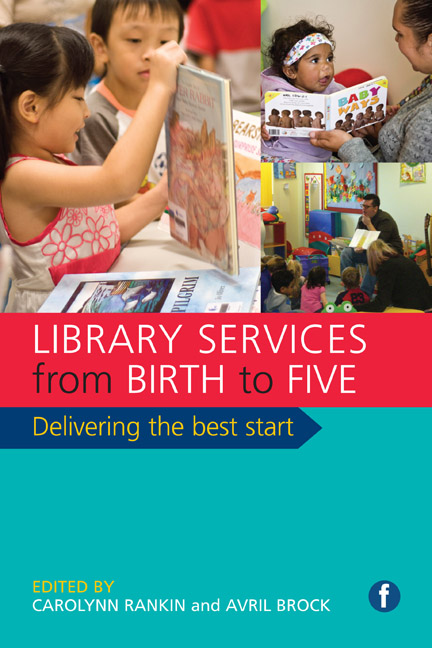Book contents
- Frontmatter
- Contents
- List of figures and tables
- Contributors
- Acknowledgements
- Introduction
- 1 Take them to the library: the pathway of opportunity
- 2 What you need to know about promoting early reading with young children from birth to five
- 3 Attribute value wrong, It should be `City of Literature ... it all starts with ABCD! The City of Melbourne and the Abecedarian Approach
- 4 Transforming practice through research: evaluating the Better Beginnings family literacy programme
- 5 People and partnerships, skills and knowledge
- 6 Resources for early years libraries: books, toys and other delights
- 7 Using digital media in early years library services
- 8 Using play to enhance early years literacy in babies and toddlers: ‘Read, Play and Grow’ at Brooklyn Public Library
- 9 Inclusive early literacy
- 10 Music and rhyme time sessions for the under-fives
- 11 Reaching your audience: the librarian's role
- 12 Successful library activities for the early years and ways to promote books effectively
- 13 Designing family-friendly libraries for the early years
- 14 Planning: organizing projects and money matters in the early years library
- Index
13 - Designing family-friendly libraries for the early years
Published online by Cambridge University Press: 08 June 2018
- Frontmatter
- Contents
- List of figures and tables
- Contributors
- Acknowledgements
- Introduction
- 1 Take them to the library: the pathway of opportunity
- 2 What you need to know about promoting early reading with young children from birth to five
- 3 Attribute value wrong, It should be `City of Literature ... it all starts with ABCD! The City of Melbourne and the Abecedarian Approach
- 4 Transforming practice through research: evaluating the Better Beginnings family literacy programme
- 5 People and partnerships, skills and knowledge
- 6 Resources for early years libraries: books, toys and other delights
- 7 Using digital media in early years library services
- 8 Using play to enhance early years literacy in babies and toddlers: ‘Read, Play and Grow’ at Brooklyn Public Library
- 9 Inclusive early literacy
- 10 Music and rhyme time sessions for the under-fives
- 11 Reaching your audience: the librarian's role
- 12 Successful library activities for the early years and ways to promote books effectively
- 13 Designing family-friendly libraries for the early years
- 14 Planning: organizing projects and money matters in the early years library
- Index
Summary
Introduction
This chapter considers the design approaches that libraries have used and reviews what makes for successfully designed library spaces for babies and young children and their families. Choosing, sharing and expressing views on books all start long before children can read, which makes the challenges and opportunities relating to library-space design for the birth-to-five age range important. The focus will be on provision for babies and young children in public libraries, but the discussion will also relate to library space in nursery schools and kindergartens.
In considering the environment and design of the early years space within the library, it is important to create a welcoming atmosphere and the ambience, layout, design, furniture and fittings will have a part to play. Guidance is provided on how you can negotiate with architects and designers to achieve this. We will encourage you to think about the use of colour, different types of furniture and equipment and how the books and resources are displayed.
While there is a reasonable amount of design guidance and information available on library spaces for older children and teens (Dewe, 1995; Lushington, 2008; Rankin, 2012), very little has been published on library design for the birth to five group. This means debates are still open and more evidence of impact needs to be gathered. We hope this chapter will raise questions and stimulate further discussion of how design can best meet the needs of this important audience.
The library as a community space: the case for the place
We will start by considering the role of the library building as a community space.
There is a strongly held view that libraries offer a welcoming, neutral space that provides opportunities for personal, cultural and community development in appropriate circumstances (Harris and Dudley, 2005, 18). Worpole (2013) cites the changing role of libraries and argues that designing libraries is about investing in people: ‘If libraries have a reputation for being universally welcoming, the new renaissance in prestigious library development projects across the world should be welcomed as a sign that the library, both as a public facility and a learning space, has a future as a place to meet, read, share and explore ideas in what might be called a ‘living room in the city’.’
- Type
- Chapter
- Information
- Library Services from Birth to FiveDelivering the best start, pp. 275 - 300Publisher: FacetPrint publication year: 2019



